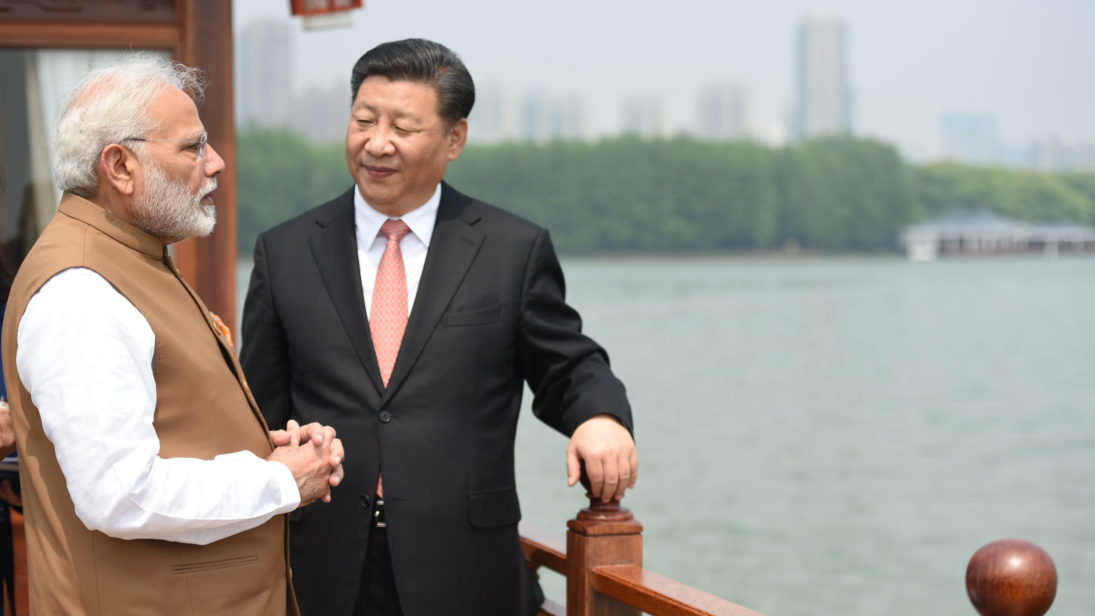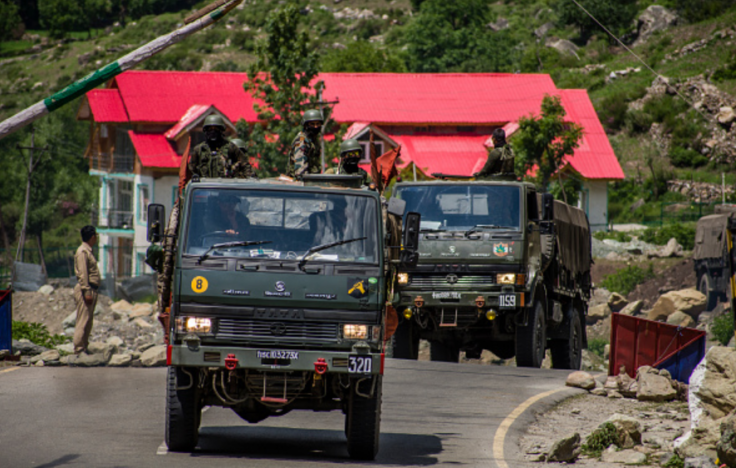
How will India-China relations evolve in 2021? Forecasting the trajectory of this complex relationship is becoming a challenging endeavor; yet its predictability is still very much drawn on both countries’ past practices, especially China’s. Competing nationalism, coupled with geopolitical interests factoring the land and maritime domain, will continue to influence India-China relations in 2021, indicating that their bilateral ties will remain far from normal in the coming year. Besides, the Chinese Communist Party’s (CCP) centenary celebration in 2021, which will no doubt ratchet up nationalism, will be a defining moment for China’s policy posture in the near future.
Clashing perceptions and rising nationalisms
In 2020, relations between the two Asian giants deteriorated due to differing perceptions of the Line of Actual Control (LAC), resulting in the Galwan clash. However, contrary to popular belief, it is not their border technicalities that have dented India-China ties, but rather rising tempers on both sides alongside more robust nationalism in each country that frames the other as an antagonistic power. Border technicalities have been a constant contentious factor in this bilateral relationship over the last seven decades. What has changed is the temperament of the current regimes in both states, which prioritize building national strength and pursuing an active and action-oriented foreign policy.
In the coming year, the CCP can be expected to celebrate its achievements by displaying a stern posture vis-à-vis India and other competitors like the United States and Japan. Acquiring territory, building an assertive maritime posture, and trying to strengthen President Xi Jinping’s “Chinese Dream” agenda are parts of such nationalistic thinking, and India’s stature as a rising power is beginning to threaten China’s regional and global ambitions. As we move into a new decade with 2021, this growing contrarian nature of Beijing-New Delhi ties implies that the relationship is set to continue along similar lines, if not become more contentious.
Border technicalities have been a constant contentious factor in this bilateral relationship over the last seven decades. What has changed is the temperament of the current regimes in both states, which prioritize building national strength and pursuing an active and action-oriented foreign policy.
There exists a clear, wide, and very real gap between the comprehensive national power (CNP) of India and China. China is already a dominant economic force due to its status as a critical manufacturing link in existing global supply chains. It is also a formidable military power that is swiftly displaying its ability to engage simultaneously on multiple fronts. On the other hand, India remains comparatively low on the economic, military and developmental totem pole. Not only is the Indian economy nearly five times smaller than that of China’s (by GDP per capita), but it also has a military that is far smaller and far less technologically advanced compared to China. Although both are nuclear-armed states, India has a gross defense budget of just over USD $71 billion, which is dwarfed by China’s annual military expenditure of USD $261 billion. This difference is reflected in the vast gap in the number of personnel, army, military and naval equipment, and nuclear warheads that each country maintains. Consequently, China enjoys a much greater ability to muster and employ its strategic resources to further national objectives and extend the grip of its national power beyond its territorial borders.
Amidst such realities and differences in both economic and military power projections, China will, almost certainly, aim to exert its desires and dominance in relation to India. Such behavior would be in keeping with Beijing’s aggressive and often coercive actions on the regional stage. China has reacted strongly to sovereign acts by other states such as Australia’s decision to support an independent inquiry into the origins and early handling of the coronavirus in China’s Wuhan province. The incident led to the imposition of several harsh economic sanctions and strongly-worded statements and warnings, with its state-owned media calling Canberra “evil” and Zhao Lijian, Beijing’s Foreign Ministry spokesperson, advising Australia to “do some soul-searching” regarding its “hostile behavior” while posting a deeply controversial and insensitive tweet. Beijing’s political retribution against Australia has become a warning to international society, reflecting the consequences of opposing Chinese interests.
India’s evolving global strategy
The evolution of India’s foreign policy and strategic thinking, coupled with a surge in nationalism, has been, and will likely continue to be, an unfavorable development for China. Beijing has long been uncomfortable with New Delhi’s growing ties with Washington, which could not only bring the United States to its southern border but also put it face-to-face with an immense alliance that would hinder its aspirations. Indeed, some analysts have labelled India a strategic “pawn” of the United States.
China’s desire to restrict India as a regional power has been further exacerbated by the latter’s vocal criticisms of Xi’s Belt and Road Initiative and New Delhi’s shift to an active foreign policy which has seen it deepening partnerships with the United States and other Indo-Pacific powers. Moving from its long-standing “Act East” policy, New Delhi has swiftly adopted the Indo-Pacific concept into its strategic thinking. Beijing no doubt realizes India’s centrality in its competition with the West, particularly the United States, and thus sees India’s Indo-Pacific approach and partnerships as a potential threat to its own interests. It increasingly perceives New Delhi’s focus on building strategic partnerships around the Indo-Pacific as a hedging attempt against Chinese interests in the region. Although India remains far behind China in terms of their CNP, these developing ties could certainly pose a threat to Chinese global ambitions. The Modi government has also accelerated the upgradation of border infrastructure along the LAC. The abrogation of article 370 and transforming Ladakh into a Union Territory only provides India greater power across the border regions, much to China’s dismay.

Moving forward, New Delhi must understand and be prepared to face strong statements and actions from Beijing in keeping with its authoritarian international and regional strategy. China has historically amassed power and stature by being a vocal and unforgiving actor. In this context, India must expect an approach based on similar characteristics within the setting of India-China ties and therefore presume China will be unwilling to pull back, compromise or take any decision that would cast a shadow on its indisputable superiority at the LAC.
At the same time, China must acknowledge India’s evolution from a mere regional power to a major power in its foreign policy ambitions. India no longer perceives itself as a power limited to its immediate region but sees itself as playing a greater role on the global stage. India holds immense potential to be the world’s fifth-largest economy by 2025 and the third-largest by 2030, subject to its recovery from the current economic slowdown. New Delhi has also been increasing its military spending in-line with its progressively more active foreign policy. The third-largest military spender in the world as of 2019, this trend of bolstering India’s military power will continue in the coming years. Additionally, India’s initiatives such as “Atmanirbhar Bharat” (self-sufficient India) and its intention to diversify away from China-centered supply chains will help reduce its economic dependence on its strategic rival.
Trust deficit
Despite their protracted rivalry, India and China may also rebuild ties in 2021, albeit to a rather limited extent. President Xi Jinping will be hosting the 100th anniversary of the founding of the CCP and the People’s Republic of China in 2021, and marking the first of China’s two centennial goals set by Xi in 2012. In reference to this occasion, Beijing will likely be looking to build more accommodative ties with India and project a stronger image. While this does not mean that Beijing will be willing to back down from its position at the LAC or even look to strengthen existing ties, there may be a refashioning or reframing of the India-China rhetoric to tone down its anti-India language within Chinese media and strategic communities. Similarly, considering the real possibility of the current border tension deteriorating and leading to a war-like situation, India will look for ways to rebuild confidence between both nations without budging or compromising from its position at the LAC.
Nevertheless, even if both states are more committed towards confidence-building measures, they will certainly be more careful in their approach and less willing to trust the other. The “trust” factor in India-China relations has historically been lacking, and any attempt from either side to build trust is unlikely to succeed. For India in particular — which sees China’s stern claim in the Galwan valley as a distinct breach of its sovereignty, a departure from bipartite consensus, and a unilateral attempt to change the status quo — means trust has now been lost permanently. Developing confidence through well-instituted mechanisms would take several years.
Even if both states are more committed towards confidence-building measures, they will certainly be more careful in their approach and less willing to trust the other. The “trust” factor in India-China relations has historically been lacking, and any attempt from either side to build trust is unlikely to succeed.
As a result, it is unlikely that there will be scope for India and China to resume their “Developmental Partnership,” which was introduced during President Xi’s state visit to India in September 2014. Seen as a major milestone in bilateral ties, both states had agreed to enhance high-level political communication and develop “strategic trust” in their consultations. After the Galwan Valley clash, however, there remain few prospects for such goals to be resumed in the short term.
In fact, trade was arguably a key conduit bringing New Delhi and Beijing together as both countries perceived the other as a vehicle for achieving positive-sum economic growth. But with bilateral tensions bringing security concerns to the forefront — as evidenced by India’s unprecedented ban on Chinese mobile apps deemed to be “prejudicial to sovereignty and integrity of India”— trade too has become a point of contention for both sides. As India looks to establish itself as a critical link in the race to dominate emerging alternative global supply chain markets and replace China as the “world’s factory,” China is becoming more of a competitor (and a strategic negator) than ever before.
Therefore, while India and China may seek to cooperate in some multilateral arenas, such as the international challenge of climate change and organizations like the BRICS, Shanghai Cooperation Organization, and the Asian Infrastructure Investment Bank, there will be little space for collaboration on a bilateral level, making continued rivalry between both major Asian powers a foregone conclusion.
Editor’s Note: A version of this piece originally appeared on 9DashLine and has been republished with permission from the editors.
***
Image 1: Ministry of External Affairs (India) via Flickr
Image 2: Yawar Nazir via Getty Images


